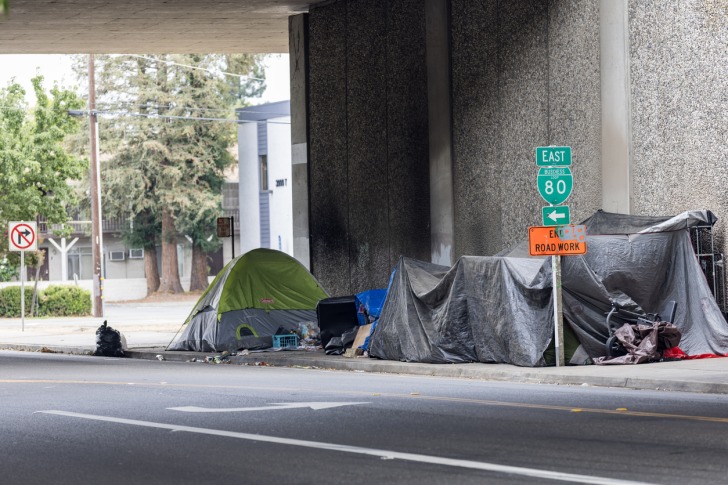Homelessness is one of the biggest problems facing our country today.
This has been a problem throughout most of modern history, but with the current rising housing costs and lack of decent-paying jobs, more and more people are finding themselves without a place to call home.
Let’s take a closer look at this problem.
Contents
The State of Homelessness by the Numbers
California leads the states in the number of homeless with 171,521 people without permanent homes.
New York follows with 74,178.
Florida, Washington, and Texas all have a homeless population of between 20,000 and 40,000.
Eight states have a homeless population of between 10,000 and 20,000.
These are Oregon, Massachusetts, Arizona, Pennsylvania, Georgia, Ohio, Tennessee, and Colorado.
There are twelve states that have a homeless population of between 5,000 and 10,000 and another 24 states that have homeless populations of between 1,000 and 5,000.
Only two states in the country, Wyoming and North Dakota, have homeless populations under 1,000.
| State | Total | Per 10k Residents |
|---|---|---|
| Alabama | 3752 | 7.4 |
| Alaska | 2320 | 31.7 |
| Arizona | 13553 | 18.6 |
| Arkansas | 2459 | 8.1 |
| California | 171521 | 43.7 |
| Colorado | 10397 | 17.9 |
| Connecticut | 2930 | 8.1 |
| Delaware | 2369 | 23.6 |
| District of Columbia | 4410 | 65.8 |
| Florida | 25959 | 11.9 |
| Georgia | 10689 | 9.9 |
| Hawaii | 5967 | 41.4 |
| Idaho | 1998 | 10.5 |
| Illinois | 9212 | 7.3 |
| Indiana | 5449 | 8 |
| Iowa | 2419 | 7.6 |
| Kansas | 2397 | 8.2 |
| Kentucky | 3984 | 8.8 |
| Louisiana | 7373 | 15.9 |
| Maine | 4411 | 32.1 |
| Maryland | 5349 | 8.7 |
| Massachusetts | 15507 | 22.2 |
| Michigan | 8206 | 8.2 |
| Minnesota | 7917 | 13.9 |
| Mississippi | 1196 | 4.1 |
| Missouri | 5992 | 9.7 |
| Montana | 1585 | 14.4 |
| Nebraska | 2246 | 11.4 |
| Nevada | 7618 | 24.2 |
| New Hampshire | 1605 | 11.6 |
| New Jersey | 8752 | 9.4 |
| New Mexico | 2560 | 12.1 |
| New York | 74178 | 37.7 |
| North Carolina | 9382 | 8.9 |
| North Dakota | 610 | 7.9 |
| Ohio | 10654 | 9 |
| Oklahoma | 3754 | 9.4 |
| Oregon | 17959 | 42.3 |
| Pennsylvania | 12691 | 9.8 |
| Rhode Island | 1577 | 14.4 |
| South Carolina | 3608 | 7 |
| South Dakota | 1389 | 15.5 |
| Tennessee | 10567 | 15.1 |
| Texas | 24432 | 8.3 |
| Utah | 3557 | 10.7 |
| Vermont | 2780 | 43.1 |
| Virginia | 6529 | 7.6 |
| Washington | 25211 | 32.6 |
| West Virginia | 1375 | 7.7 |
| Wisconsin | 4775 | 8.1 |
| Wyoming | 648 | 11.2 |
What is Homelessness?
Homelessness is often thought of as the man sleeping on a park bench with his belongings in a shopping cart.
It is pictured as people lined up for a bed at a homeless shelter, or sitting outside a popular store and begging for money.
There is a lot more to it than that.
Homelessness is not having a secure place to call home.
Homelessness is the family living out of a van because they can’t afford rent.
It’s the young man sleeping on someone’s couch because his parents threw him out.
It’s the veteran living in a tent in the city’s homeless tent city or the young couple who have set up camp under a bridge.
When numbers of homeless individuals are collected, many of these unseen homeless go uncounted, so the numbers are actually higher than we believe.
What Contributes to Homelessness?
There are many factors that come into play in regard to homelessness.
Many people become homeless due to mental or physical disabilities that make it difficult for them to hold a job.
This group often includes veterans who suffer from PTSD as well as physical disabilities.
Young families may find themselves without a home even though they have jobs.
Many of today’s positions can see two people in a family working and still not allowing them to afford housing.
There is a large youth population within the homeless community.
Many of these are victims of child abuse, parents who don’t accept them for one reason or another, or people who have aged out of the foster home system and don’t have anywhere to go.
Despite popular belief, drug addicts make up a smaller portion of the homeless population than people think, although many of those who are homeless turn to drugs or alcohol to try and cope with the situation.
Frequently Asked Questions
What states are making progress in combating the homelessness issue?
Colorado has ranked at the top in providing housing assistance and has seen a decrease in homelessness.
Connecticut has also made good progress by lowering the percentage of those who were homeless by 23.6 percent from 2018 to 2019.
Is it really illegal to be homeless?
Many states do make homelessness illegal, but the majority of states, while not specifically making it illegal, target the homeless population by making it illegal to do things like sleep in public, spending time in retail areas without buying things, or cluttering sidewalks with personal belongings.
The only two states that do not make homelessness, or at least the necessary actions required of the homeless, illegal are Oregon and Wyoming.
What states have the highest and lowest percentage of homelessness based on their population?
The District of Columbia (D.C>) has the highest percentage of homelessness with 65.8 out of every 10,000 persons being without permanent housing.
Mississippi has the lowest percentage rate with only 4.1 out of every 10,000 persons being homeless.












It’s heartbreaking to see the high number of homeless individuals in each state. We need to do more as a society to provide resources and support for those in need. Every person deserves a safe and stable place to call home.